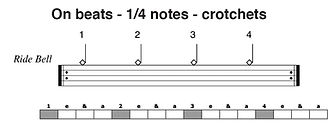Easy-read design
Beats Exotiques makes it simple for learners with no previous experience reading music to understand and perform even complex rhythms. By using box notation with counts, it becomes really easy to visualise the patterns, allowing learners to "see” the rhythms.
Because this box notation appears alongside traditional music notation, Beats Exotiques helps learners to make a mental connection between the boxes and musical notes and rests, improving their ability to read music.
Box notation key



Counts appear on both the musical notation & the box notations
-
1/4 notes (crotchets) are counted 1 2 3 4
-
1/8 notes (Quavers) are counted 1 & 2 & 3 & 4 &
-
16th notes (Semi Quavers) are counted in groups of
four 1e&a 2e&a 3e&a 4e&a
-
1/8 notes (Quavers) 1 & 2 & 3 & 4 &
Quarter notes with "&" counted between
-
Bo Diddley beat
This is how the notation looks for the Cuban clave which inspired the famous Bo Diddley beat .




Box notation pages
Beats Exotiques makes it easy to quickly see all the 850+ box notations by presenting them together at the end each chapter.
Beats-Makers, DJs and Producers are tapping into this powerful world rhythm resource and using it in their step sequencing workflow.
Double page spreads
It's easy to see the twelve leg patterns - bass & foot hi-hat - with snare backbeat grooves on the left hand page.
It's easy to see the ride cymbal bell patterns on the right hand page and to mix them together.
Using a premium Wire-O coil binding the pages lie flatter and easy to view.
Legs - Left hand page
Ride bell Right hand page






